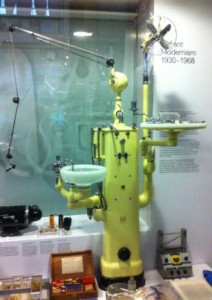 The Dental Manufacturing Company Dental Unit, 1945-55
The Dental Manufacturing Company Dental Unit, 1945-55
In July 1948, the NHS was opened by Labour health minister Bevan, making dental treatment available to the whole population, free of charge, for the first time. This sudden expansion of treatment meant that, at first, there was a shortage of specialist dental equipment. The Dental Manufacturing created, with units such as this (1) that were instrumental in providing affordable health care to all.
During the Second World War, the state had unprecedented control over people’s lives, including the care of civilians injured in bombing raids. Other government measures, such as rationing, had led to the health of the poorest in society improving (2) . The NHS was part of a programme of reforms designed to rebuild Britain after the devastation of WW2, taking advantage of the progress made in public health and the normalisation of state-controlled resources. It was, to the Labour government of the day, the ‘realisation of a socialist dream’ (3) ; improving welfare was a key priority of the left-wing elements of the Post-War Consensus.
WW2 led to an increased government interest in science, especially that which would benefit the military. This political support for science extended in the post-war years to include the social sciences and medicine. The first decade of the NHS saw previously unprecedented advances in medical science and technology, primarily driven by the Medical Research Council (4) . The government was investing not just in public health provision, but also in medical technologies and research as part of an increasing inter-dependence between non-military sciences and government.
The NHS was founded at a time when one devastating war had ended with the use of the ultimate destructive force in the atomic bomb, and the Cold War was beginning; in the eyes of many, irresponsible science was to blame for the absolute threat war now posed. The NHS and the benefits it brought presented the positive, constructive side of science to the public. The 1951 Festival of Britain promoted the idea of British technology and science, both in the past and into the future, as progressive and beneficial, and medical progress was included in this. The Dental Unit is an embodiment of these optimistic ideals.
by Caitlin Page
- Science Museum ‘ ‘Rathbone’ Dental Unit, England, 1946-1955’ http://www.sciencemuseum.org.uk/broughttolife/objects/display.aspx?id=6729 (accessed 25/11/2011)
- ‘Origins of the National Health Service’ http://www.nationalarchives.gov.uk/cabinetpapers/alevelstudies/origins-nhs.htm (accessed 25/11/2011)
- ‘Making Britain Better’ http://news.bbc.co.uk/1/hi/events/nhs_at_50/special_report/119803.stm (accessed 25/11/2011)
- John Steward, ‘The Political Economy of the British National Health Service, 1945-1975: Opportunities and Constraints?’ in Medical History Vol. 52, Issue 4 (October 2008) pp. 453-470

Recent Comments